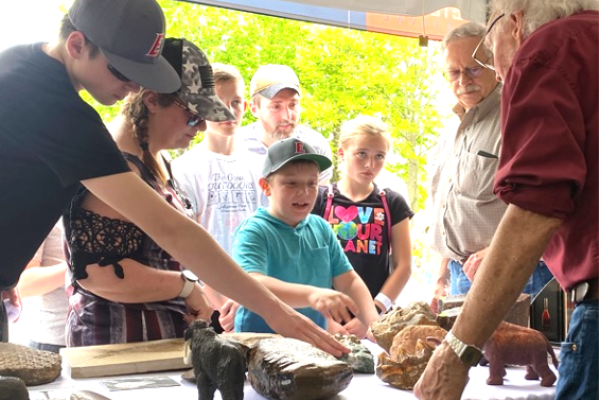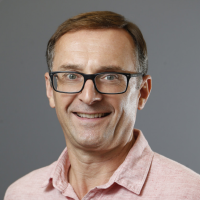Outreach and Engagement at the Orton Museum

Since its inception, the Orton Geological Museum, along with its parent unit, the Department of Geology (now the School of Earth Sciences), has maintained a close link with the community. Both the museum and the school have advocated the importance of science and science education for the benefit of society. As we reflect with pride on our 150-year history, it is worth taking stock of where we stand now with respect to our relationship to the community and society. Some of our most impressive efforts at connecting with people around the community, around the state, and around the world involve the diverse activities that we view collectively as outreach and engagement.
How long has the Orton Museum committed to a program of community engagement? Since 1873-1874, The Ohio State University, and most notably the Orton Museum, have maintained close ties to the Geological Survey of Ohio (now the Ohio Department of Natural Resources, Division of Geological Survey), an organization that has provided, and continues to provide, extraordinary service in the public interest. Much of the early development of the Orton Museum’s geological collections are the result of Geological Survey research in the State of Ohio. From 1882, the Chief of the Geological Survey has normally participated in the university’s research, teaching, and outreach missions as a faculty member. This two-way interaction has been a powerful driver of science education and economic expansion in Ohio.
What are the forms of Orton Museum engagement today, and what is their impact on society? Assessing and understanding a museum’s impact on the community can take varied forms. Numerical data tell part of the story. For example, last year the Orton Museum gallery received >30,000 visitors. In-person contacts with interested people at internal venues such as WestFest, and external venues such as COSI’s Big Science Festival, rock and mineral shows, and state and county fairs, add more than 10,000 additional people to the list of those whose lives have been touched by our work. Another way of thinking about our impact is by scanning social media and web pages for photos of objects on campus. Doing that reveals many photos of Ohio Stadium (no surprise), but the next three most commonly appearing objects in online searches are photos of Orton Hall, the Antarctic dinosaur skeleton (Cryolophosaurus), and the giant ground sloth skeleton (Megalonyx, affectionately known as Jeff). This is an ongoing, unspoken, but nevertheless hugely important and impactful, connection with our community.
There is little doubt that we make the greatest inroads with people when we have the opportunity to speak directly to them, and offer the opportunity to see and touch firsthand the types of objects we study, or to directly engage in our research. Today that type of engagement involves a range of formats. The museum provides a stimulating teaching and learning space for students of all ages, pre-kindergarten through university age, and even for adults interested in non-credit-yielding educational experiences. We accommodate people representing an exceptional range of educational and life experiences. Many of those who come to visit the museum arrive with tour groups. The public gallery tour is popular, but those with a deeper interest in the science behind the exhibits may take tours of the collections areas. This usually opens people’s eyes to a whole new understanding of the role of museums in society, and leads to new levels of inquisitiveness. Occasional open-houses, such as the recent celebration of our dinosaur installation, draw hundreds of people who might not otherwise find opportunities to visit and talk with us. Normally each year we lead groups on a few field trips beyond the confines of the university campus. A tour of the building stones of the Ohio Statehouse is popular, but trips to collecting localities in Ohio or elsewhere also generate interest among those who love to spend time in our natural surroundings and learn about the fascinating geologic history of the world around us.
One important, but underemphasized, aspect of our engagement with the community is specimen identifications. How often have you found a rock, mineral, or fossil you couldn’t identify? We offer help with identifying some of these unknowns. Last year we identified more than 600 specimens for members of the public. Some of the specimens that are brought to us turn out to have scientific research value. When donated to the museum, we recognize the donor’s generosity in the museum’s permanent record. What a wonderful legacy to leave for future generations!
Some of our most impactful outreach and engagement activities involve the partnerships that we have forged with community organizations. An ongoing project to provide STEM (Science, Technology, Engineering, and Mathematics) enrichment to the Columbus Gifted Academy, part of the Columbus City Schools system, has met with great success. This work even involves a research project that incorporates middle school students, as well as university students, in the discovery process. We are partnering with libraries in central Ohio, and with COSI, to provide specimens and content for exhibition, which assists in their outreach and engagement missions.
Of course, there are other ways that we engage with people inside and outside the university community, but among those that are most recognizable are our media interviews and postings on digital media. The Orton Museum’s webpage receives >250,000 clicks annually. It’s a tremendous resource for information about the museum and its mission, and about the university more generally, including information about other collections and resources on campus. For each of the past few years, during Earth History Week, we have posted a digital exhibition series on the museum website called “Stones with Stories,” and highlighted rocks, minerals, or fossils that have interesting tales to tell. This is the URL for the 2023 installment: https://ortongeologicalmuseum.osu.edu/gallery/digital-exhibit-stones-stories-2023. At the conclusion of Earth History Week, the highlighted specimens are incorporated in the museum’s public gallery as a short-term display. The Stones with Stories exhibits have become one of our most popular displays, as evident from the “fingerprints-on-glass” method of assessment. We love it that the glass needs to be wiped clean so frequently!
Loren E. Babcock


